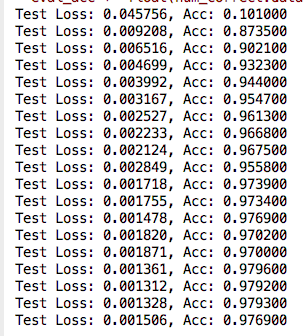小编给大家分享一下pytorch中cnn如何识别手写的字并实现自建图片数据,相信大部分人都还不怎么了解,因此分享这篇文章给大家参考一下,希望大家阅读完这篇文章后大有收获,下面让我们一起去了解一下吧!
具体如下:
# library
# standard library
import os
# third-party library
import torch
import torch.nn as nn
from torch.autograd import Variable
from torch.utils.data import Dataset, DataLoader
import torchvision
import matplotlib.pyplot as plt
from PIL import Image
import numpy as np
# torch.manual_seed(1) # reproducible
# Hyper Parameters
EPOCH = 1 # train the training data n times, to save time, we just train 1 epoch
BATCH_SIZE = 50
LR = 0.001 # learning rate
root = "./mnist/raw/"
def default_loader(path):
# return Image.open(path).convert('RGB')
return Image.open(path)
class MyDataset(Dataset):
def __init__(self, txt, transform=None, target_transform=None, loader=default_loader):
fh = open(txt, 'r')
imgs = []
for line in fh:
line = line.strip('\n')
line = line.rstrip()
words = line.split()
imgs.append((words[0], int(words[1])))
self.imgs = imgs
self.transform = transform
self.target_transform = target_transform
self.loader = loader
fh.close()
def __getitem__(self, index):
fn, label = self.imgs[index]
img = self.loader(fn)
img = Image.fromarray(np.array(img), mode='L')
if self.transform is not None:
img = self.transform(img)
return img,label
def __len__(self):
return len(self.imgs)
train_data = MyDataset(txt= root + 'train.txt', transform = torchvision.transforms.ToTensor())
train_loader = DataLoader(dataset = train_data, batch_size=BATCH_SIZE, shuffle=True)
test_data = MyDataset(txt= root + 'test.txt', transform = torchvision.transforms.ToTensor())
test_loader = DataLoader(dataset = test_data, batch_size=BATCH_SIZE)
class CNN(nn.Module):
def __init__(self):
super(CNN, self).__init__()
self.conv1 = nn.Sequential( # input shape (1, 28, 28)
nn.Conv2d(
in_channels=1, # input height
out_channels=16, # n_filters
kernel_size=5, # filter size
stride=1, # filter movement/step
padding=2, # if want same width and length of this image after con2d, padding=(kernel_size-1)/2 if stride=1
), # output shape (16, 28, 28)
nn.ReLU(), # activation
nn.MaxPool2d(kernel_size=2), # choose max value in 2x2 area, output shape (16, 14, 14)
)
self.conv2 = nn.Sequential( # input shape (16, 14, 14)
nn.Conv2d(16, 32, 5, 1, 2), # output shape (32, 14, 14)
nn.ReLU(), # activation
nn.MaxPool2d(2), # output shape (32, 7, 7)
)
self.out = nn.Linear(32 * 7 * 7, 10) # fully connected layer, output 10 classes
def forward(self, x):
x = self.conv1(x)
x = self.conv2(x)
x = x.view(x.size(0), -1) # flatten the output of conv2 to (batch_size, 32 * 7 * 7)
output = self.out(x)
return output, x # return x for visualization
cnn = CNN()
print(cnn) # net architecture
optimizer = torch.optim.Adam(cnn.parameters(), lr=LR) # optimize all cnn parameters
loss_func = nn.CrossEntropyLoss() # the target label is not one-hotted
# training and testing
for epoch in range(EPOCH):
for step, (x, y) in enumerate(train_loader): # gives batch data, normalize x when iterate train_loader
b_x = Variable(x) # batch x
b_y = Variable(y) # batch y
output = cnn(b_x)[0] # cnn output
loss = loss_func(output, b_y) # cross entropy loss
optimizer.zero_grad() # clear gradients for this training step
loss.backward() # backpropagation, compute gradients
optimizer.step() # apply gradients
if step % 50 == 0:
cnn.eval()
eval_loss = 0.
eval_acc = 0.
for i, (tx, ty) in enumerate(test_loader):
t_x = Variable(tx)
t_y = Variable(ty)
output = cnn(t_x)[0]
loss = loss_func(output, t_y)
eval_loss += loss.data[0]
pred = torch.max(output, 1)[1]
num_correct = (pred == t_y).sum()
eval_acc += float(num_correct.data[0])
acc_rate = eval_acc / float(len(test_data))
print('Test Loss: {:.6f}, Acc: {:.6f}'.format(eval_loss / (len(test_data)), acc_rate))图片和label 见上一篇文章《pytorch 把MNIST数据集转换成图片和txt》
结果如下:

以上是“pytorch中cnn如何识别手写的字并实现自建图片数据”这篇文章的所有内容,感谢各位的阅读!相信大家都有了一定的了解,希望分享的内容对大家有所帮助,如果还想学习更多知识,欢迎关注亿速云行业资讯频道!
亿速云「云服务器」,即开即用、新一代英特尔至强铂金CPU、三副本存储NVMe SSD云盘,价格低至29元/月。点击查看>>
免责声明:本站发布的内容(图片、视频和文字)以原创、转载和分享为主,文章观点不代表本网站立场,如果涉及侵权请联系站长邮箱:is@yisu.com进行举报,并提供相关证据,一经查实,将立刻删除涉嫌侵权内容。